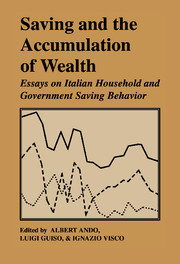Book contents
- Frontmatter
- Contents
- Foreword by Antonio Fazio
- List of contributors
- List of figures
- List of tables
- Acknowledgments
- Introduction
- I Saving trends, government deficit and demographic changes
- 1 Why is Italy's saving rate so high?
- 2 Private saving and the government deficit in Italy
- 3 Do demographic changes explain the decline in the saving rate of Italian households?
- 4 Generational accounting. The case of Italy
- II Life-cycle saving and precautionary motives
- III Borrowing constraints, intergenerational transfers and bequests
- Appendixes
- Index
2 - Private saving and the government deficit in Italy
Published online by Cambridge University Press: 05 May 2010
- Frontmatter
- Contents
- Foreword by Antonio Fazio
- List of contributors
- List of figures
- List of tables
- Acknowledgments
- Introduction
- I Saving trends, government deficit and demographic changes
- 1 Why is Italy's saving rate so high?
- 2 Private saving and the government deficit in Italy
- 3 Do demographic changes explain the decline in the saving rate of Italian households?
- 4 Generational accounting. The case of Italy
- II Life-cycle saving and precautionary motives
- III Borrowing constraints, intergenerational transfers and bequests
- Appendixes
- Index
Summary
Introduction
According to official sources, aggregate Italian saving rates have declined substantially in recent years. The precise timing and extent of this change largely depend on the definition of saving adopted and on the researcher's attitude toward the host of measurement issues involved. However, major trends are undisputably under way with regard to gross and net rates, national and private measures and “adjusted” and “unadjusted” values, and provide a rather surprising description of the behavior of Italian consumers.
In the second half of the eighties private saving rates (net of depreciation, adjusted for durables and inflation and computed as ratios to net national disposable income) fluctuated around 14 percent, 5 percentage points lower than the average in the sixties. In the same years government saving (adjusted for inflation) plunged to an unprecedented minus 1 percent, after more than thirty years of current account surpluses averaging 3 percent. As a result, the overall Italian saving rate is 9 percentage points lower today than during the so–called “Italian economic miracle”.
Several alternative explanations for the fall in the saving rate have been put forward in recent research. In particular, the impact of fiscal policy on private sector behavior has been repeatedly scrutinized, although no definite conclusion has been drawn. Nevertheless, this paper proposes that a thorough assessment of the interplay of private and public decisions can shed light on the evolution of the saving rate in recent decades.
- Type
- Chapter
- Information
- Saving and the Accumulation of WealthEssays on Italian Household and Government Saving Behavior, pp. 70 - 105Publisher: Cambridge University PressPrint publication year: 1994
- 5
- Cited by



